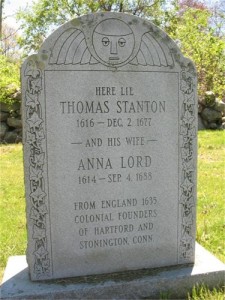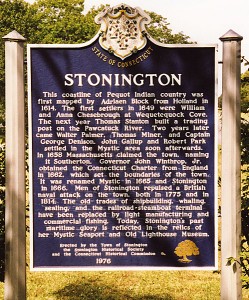founder
 In trying to connect the Stanton side that exists through my dad’s half brother, Norman Willis Spencer, to the Stanton side that exists in Bob’s family through his grandma, Nettie Noyes Knox, I have come up with some interesting information. While I have not made the connection that I’m almost certain exists between the two sides, I did find out that within the Noyes side of the family, there is a Stanton family member who was of some significance to America too. His name was Thomas Stanton, and he was Bob’s 7th great grandfather. There are many ways for a person to have a degree of influence on American history, or history of any nation. Some people become kings or presidents. Others might have been great warriors, while still others might have made some great discovery.
In trying to connect the Stanton side that exists through my dad’s half brother, Norman Willis Spencer, to the Stanton side that exists in Bob’s family through his grandma, Nettie Noyes Knox, I have come up with some interesting information. While I have not made the connection that I’m almost certain exists between the two sides, I did find out that within the Noyes side of the family, there is a Stanton family member who was of some significance to America too. His name was Thomas Stanton, and he was Bob’s 7th great grandfather. There are many ways for a person to have a degree of influence on American history, or history of any nation. Some people become kings or presidents. Others might have been great warriors, while still others might have made some great discovery.
Thomas Stanton was a trader and an accomplished Indian interpreter and negotiator in the colony of Connecticut. He is first noted in historical records as an interpreter for John Winthrop Jr in 1636. He fought in the Pequot War, which took place between 1634 and 1638. He nearly lost his life in the Fairfield Swamp Fight in 1637. In 1638 he was a delegate at the Treaty of Hartford, which ended the war. In 1643, the United Colonies of New England appointed Stanton as Indian Interpreter.
He began a close alliance with the Thomas Lord family, who may have been friends from England and who had recently emigrated from Towcester, England. He married Thomas Lord’s daughter, Anna Lord, about 1636 and went into a merchant business alliance with Richard Lord. Some of Thomas’ land transactions involved serious difficulties, because people often sold and resold land without obtaining a clear title. An Indian sachem gave Quonochontaug to Stanton, but did the chief really own all of this land? A Stanton tract might overlap a tract claimed by another settler. These and other transactions like them, resulted in lengthy and costly litigation. Questions about the ownership of some of Stanton’s land and ambiguities in the will led to years of family and legal fighting.
But, probably the biggest claim to fame that Thomas Stanton had was that he was one of the four founders of Stonington, Connecticut, and one of the first settlers of Hartford, Connecticut. The present territory of Stonington was part of lands that had belonged to the Pequot people, who referred to the areas making up Stonington as Pawcatuck and Mistack. It was named  “Souther Towne” or Southerton by Massachusetts in 1658. It became part of Connecticut in 1662 when Connecticut received its royal charter. Southerton was renamed “Mistick” in 1665 and again renamed Stonington in 1666. Thomas Miner, Walter Palmer, William Chesebrough and Thomas Stanton were its four founders.
“Souther Towne” or Southerton by Massachusetts in 1658. It became part of Connecticut in 1662 when Connecticut received its royal charter. Southerton was renamed “Mistick” in 1665 and again renamed Stonington in 1666. Thomas Miner, Walter Palmer, William Chesebrough and Thomas Stanton were its four founders.
Upon Thomas death on Dec 2,1677, his will could not be located, and legal battles concerning the distribution of his property continued for years. When his wife, Anna died 11 years later, his estate was still unsettled. At some point, when going through some papers belonging to the city of Hartford, Connecticut, someone found the will, but that would not bring the estate to the point of being settled. The estate remained unsettled for a total of 40 years before the will was accepted and the estate settled. That is the kind of thing that can happen when money and land are involved.

